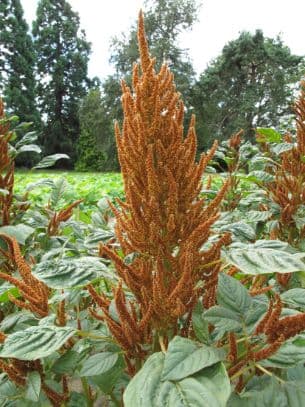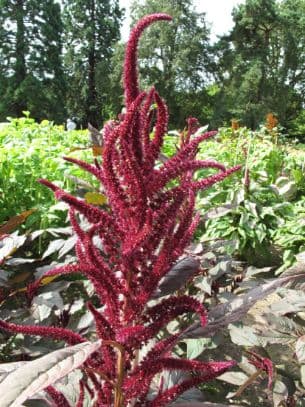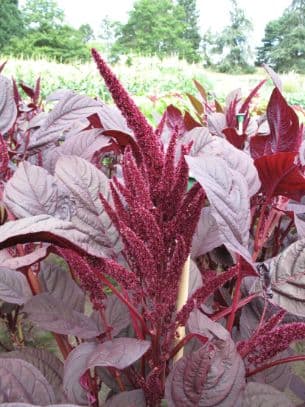Spinach Spinacia oleracea 'Amazon'

ABOUT
Spinacia oleracea 'Amazon', commonly known as spinach, features vibrant green leaves that are both broad and tender, characterized by a slightly wrinkled and veiny texture. The leaves are arranged in a rosette pattern, emerging from a central point and creating a circular display of foliage. Each leaf is attached to a slender stem that provides support and facilitates nutrient transport. The edges of the leaves can vary from smooth to slightly toothed, contributing to the plant's overall texture and visual interest. The leaves of this cultivar are typically lush and may appear to have a glossy or semi-glossy sheen under natural light, reflecting the plant's health and vigorous growth habit. During its growth cycle, the spinach may develop small flowers, though they are not particularly ornamental and are often inconspicuous compared to the prominent foliage.
About this plant
 Names
NamesFamily
Amaranthaceae
Synonyms
Spinach
Common names
Spinacia oleracea.
 Toxicity
ToxicityTo humans
Spinach, specifically the Spinacia oleracea 'Amazon' variety, is not considered toxic to humans when consumed in typical food quantities. However, spinach does contain oxalates, which in very high amounts can lead to the formation of kidney stones in susceptible individuals. Additionally, consuming extremely large amounts of spinach could lead to vitamin K overload, which can be an issue for individuals taking blood thinners. Nevertheless, in usual dietary amounts, spinach is safe and nutritious for human consumption.
To pets
Spinach, including the Spinacia oleracea 'Amazon', is generally not poisonous to pets, but it does contain oxalates which can potentially cause problems if consumed in large quantities. Pets that ingest large amounts of spinach might experience digestive upset, or in severe cases, kidney damage due to the oxalates contributing to the formation of calcium oxalate crystals. However, in small to moderate amounts, spinach is typically safe for pets. Pet owners should be cautious and consult with a veterinarian especially if their pets have known health concerns that could be exacerbated by oxalate consumption.
 Characteristics
CharacteristicsLife cycle
Annuals
Foliage type
Deciduous
Color of leaves
Green
Height
1 foot (30 cm)
Spread
1 foot (30 cm)
Plant type
Herb
Hardiness zones
2-11
Native area
Southwest Asia
Benefits
 General Benefits
General Benefits- High Nutritional Value: Spinach (Spinacia oleracea 'Amazon') is a powerful source of vitamins and minerals, including iron, calcium, magnesium, and vitamins A, C, and K.
- Dietary Fiber: Provides dietary fiber which aids in digestion and maintains gastrointestinal health.
- Low in Calories: It is a low-calorie vegetable, making it a great choice for weight management diets.
- Hydration: Spinach has a high water content, which helps in hydrating the body.
- Culinary Versatility: Can be eaten raw or cooked, and is used in a variety of dishes such as salads, soups, and casseroles.
- Aesthetic Appeal: Has vibrant green leaves that can add color and visual appeal to a variety of dishes.
- Quick to Grow: Spinach is a fast-growing plant, enabling multiple harvests in a single growing season.
- Cold Tolerance: It can withstand cooler temperatures, making it suitable for early spring and late fall planting.
- Compact Growth: Due to its relatively small size, spinach can be grown in containers, making it accessible for urban gardening.
- Soil Health: Regularly growing spinach can contribute to soil health by cycling nutrients and providing ground cover.
 Medical Properties
Medical Properties- Rich in Vitamins: Spinach (Spinacia oleracea 'Amazon') is known for its high vitamin content, particularly vitamins A, C, and K, which are essential for maintaining skin health, immune function, and blood clotting.
- Mineral Source: Spinach is a good source of minerals such as iron, which is vital for the formation of hemoglobin, and magnesium, which is important for nerve and muscle function.
- Antioxidant-rich: Spinach contains antioxidants such as lutein and zeaxanthin that may help protect the eyes from cataracts and age-related macular degeneration.
- Inflammation Reduction: It has anti-inflammatory properties due to the presence of compounds like neoxanthin and violaxanthin that may help reduce inflammation in the body.
- Bone Health: The vitamin K in spinach contributes to maintaining strong bones by aiding in calcium absorption and bone mineralization.
- Heart Health: Potassium present in spinach helps to maintain normal blood pressure levels, while folate contributes to heart health by managing homocysteine levels.
- Anti-cancer Potential: Some studies suggest that spinach may have anti-cancer properties due to its high content of flavonoids, which can slow down cell division in human stomach and skin cancer cells.
- Gastrointestinal Health: Spinach has high fiber content, which aids in digestion and prevents constipation.
 Air-purifying Qualities
Air-purifying QualitiesThis plant is not specifically known for air purifying qualities.
 Other Uses
Other Uses- Spinach ('Amazon' variety) can serve as a natural dye for textiles, imparting a range of green hues depending on processing and mordants used.
- In craftwork, spinach leaves can be pressed and preserved to create botanical artwork or organic decorations for greeting cards and eco-friendly art projects.
- As a fun educational tool, spinach can be used for simple science experiments in schools that demonstrate photosynthesis and plant biology.
- In culinary arts, chefs can use it to naturally color pastas, baked goods, and desserts green without the need for artificial food colorings.
- Spinach can be used in homemade papermaking processes, where its fibers are incorporated into the pulp to add texture and natural coloring.
- In the gardening world, spinach can be planted as a companion plant to strawberries, since they are said to grow well together and potentially improve each other's health and yield.
- The plant's sturdy leaves can be creatively used in garnishing and food presentation, such as making spinach leaf bowls for serving cold appetizers or salads.
- Spinach seeds can become part of seed tape or seed bombs, projects for gardeners to easily space out their crops or engage in guerrilla gardening.
- For natural cleaning, spinach leaves can be rubbed on surfaces to use their oxalic acid content for removing rust from old metal objects.
- As a pigment, spinach can be incorporated into natural children's play dough or finger paints, providing a safe, non-toxic alternative to synthetic options.
Interesting Facts
 Feng Shui
Feng ShuiThe Spinach is not used in Feng Shui practice.
 Zodiac Sign Compitability
Zodiac Sign CompitabilityThe Spinach is not used in astrology practice.
 Plant Symbolism
Plant Symbolism- Strength: Since it's popularly known for its iron content, spinach symbolizes strength and vigor.
- Health: Spinach is loaded with nutrients and represents good health and nutrition.
- Growth: The fast-growing nature of spinach can symbolize personal or spiritual growth.
- Purity: Its green color often relates to purity and cleanliness in a symbolic context.
- Prosperity: The lushness of healthy spinach plants is sometimes associated with abundance and prosperity.
 Water
WaterSpinach requires regular watering to keep the soil consistently moist, but not waterlogged. Water spinach plants evenly with about an inch of water per week; during hot, dry spells, you may need to water more frequently to maintain the soil moisture. It's best to water in the morning to allow any excess moisture on the leaves to dry throughout the day, reducing the risk of fungal diseases. Avoid overhead watering to prevent soil splashing up onto the leaves, which can lead to disease; instead, water at the base of the plant. In terms of volume, this amounts to roughly 0.5 to 0.625 gallons per square yard, per week, under normal weather conditions.
 Light
LightSpinach prefers a sunny spot with at least six hours of direct sunlight per day. However, it can tolerate partial shade and might even benefit from it in hotter climates where the sun is more intense. The ideal spot provides morning sunlight with some afternoon shade to prevent the plant from bolting in high temperatures.
 Temperature
TemperatureSpinach thrives in cool weather and can tolerate a light frost. The ideal temperature range is between 50°F and 70°F. It is hardy in temperatures as low as 20°F and as high as 75°F, but growth may be stunted or the plant may bolt if temperatures exceed this range.
 Pruning
PruningSpinach does not require traditional pruning, but regular harvesting of the outer leaves can promote new growth and extend the production period. Pinching off the tips can also delay bolting. The best time to harvest is in the morning when the leaves are most crisp. Periodic removal of damaged or yellowing leaves is also beneficial.
 Cleaning
CleaningAs needed
 Soil
SoilSpinach 'Amazon' thrives in a well-draining soil mix with plenty of organic matter, such as a blend of loam, compost, and peat with a pH range of 6.0 to 7.0. Aeration and moisture retention are key, and a balanced, slow-release fertilizer can be mixed in to support growth.
 Repotting
RepottingSpinach 'Amazon' is an annual plant and does not typically require repotting as it will complete its life cycle within a single growing season.
 Humidity & Misting
Humidity & MistingSpinach 'Amazon' prefers moderate humidity levels but is quite adaptable and does not require specific humidity controls when grown in a typical garden setting.
 Suitable locations
Suitable locationsIndoor
Place in a sunny spot and keep soil moist.
Outdoor
Plant in rich soil, full to partial sun.
Hardiness zone
2-11 USDA
 Life cycle
Life cycleSpinach (Spinacia oleracea 'Amazon') begins its life cycle when seeds are sown into well-draining soil and germinate, which typically takes 5 to 9 days depending on the soil temperature. After germination, seedlings emerge and enter the vegetative growth stage, developing a rosette of leaves and establishing a root system. The plant matures into this leaf production stage, during which time it can be harvested for edible leaves; in optimal conditions, this can occur within 40 to 45 days. As the plant ages or if exposed to longer daylight hours, it enters the bolting stage, where it starts growing a flowering stalk to produce flowers and seeds. Once pollinated, usually by wind, the flowers produce seeds, completing the reproductive stage. Finally, after seed set, the plant enters senescence and dies, with the seeds ready to begin the next generation when conditions are favorable.
 Propogation
PropogationPropogation time
Spring to early summer
Spinach, specifically the cultivar Spinacia oleracea 'Amazon', is typically propagated through seeds. The most popular method of propagation for this plant is direct seeding. The best time to sow spinach seeds is in early spring or fall, as spinach prefers cool weather and tends to bolt in high heat. To propagate, seeds should be sown about 1/2 inch deep (about 1.3 cm) into well-tilled soil that has been enriched with compost or organic matter. Seeds should be spaced approximately 1 inch (2.54 cm) apart in rows that are 12 to 18 inches (30 to 46 cm) apart. After sowing, the soil should be kept moist to ensure germination. Seedlings typically emerge within 5 to 14 days, and thinning is recommended once the plants have a few true leaves, leaving 3 to 5 inches (7.6 to 12.7 cm) between plants.









